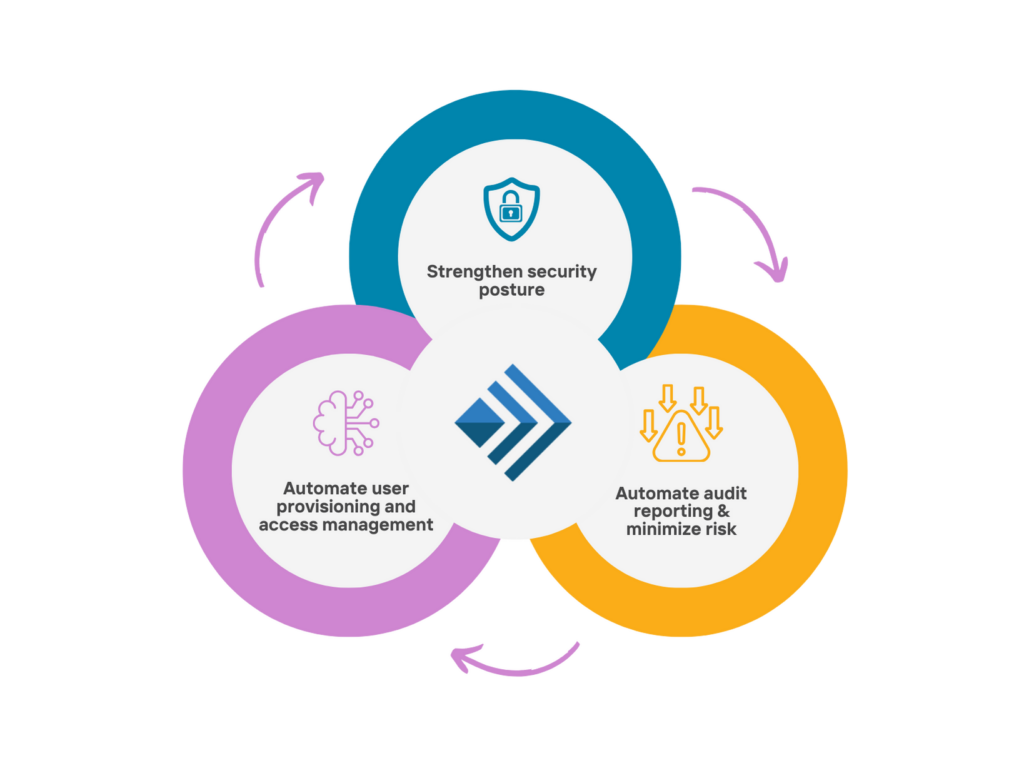
The Importance of IAM Management
In today’s digital landscape, Identity and Access Management (IAM) ensures security, efficiency, and compliance within organizations. Effective IAM involves managing permissions, automation, and digital identity. A comprehensive IAM management strategy is essential for businesses to protect sensitive data, streamline workflows, and adhere to industry regulations. In addition, IAM management is an ongoing process. It requires companies to be proactive and adaptable to the ever-evolving technology landscape.
This blog explores the various components of IAM management, emerging technologies, and how organizations can create a more robust and effective IAM strategy.
Authentication and Access Control
The Foundation of IAM authentication is a critical aspect of IAM management. It verifies the digital identity of users attempting to access organizational resources. Access management systems, including IAM tools, are essential for implementing robust authentication processes. They also ensure that only authorized individuals can access sensitive data and resources.
Access control defines the level of access granted to authenticated users. Role-based access control (RBAC) and attribute-based access control (ABAC) are two common access control models. Both models aim to limit user access to the appropriate resources based on organizational roles and responsibilities. Understanding and implementing access policies and secure access controls can significantly enhance the efficiency and security of your IAM management.
Single Sign-On and Multi-Factor Authentication
Single Sign-On (SSO) enables users to access multiple applications or services with single credentials. This reduces the need for numerous passwords. SSO simplifies the user experience and helps organizations streamline workflows by consolidating user identity management. However, it remains essential to maintain data security by incorporating additional layers of protection. Where SSO offers convenience, Multi-Factor Authentication (MFA) builds security.
MFA adds an additional layer of security by requiring users to provide two or more separate authentication factors. It combines something the user knows (e.g., password), something the user has (e.g., security token), and something the user is (e.g., biometric information). These authentication factors minimize the risk of unauthorized access, even if an authentication factor is compromised. As we explore the future of IAM management, it’s crucial to consider emerging technologies and trends that can further enhance security and efficiency.
IoT, Biometrics, and Zero Trust: Embracing Future Technologies and Trends
The Internet of Things (IoT) has introduced new challenges and opportunities for IAM management. For example, with increasingly interconnected devices greatly increase potential attack surfaces. Your organization must properly authenticate and authorize these devices before granting them access to resources. Therefore, IAM management strategies should be designed with IoT devices in mind, including secure device enrollment and lifecycle management.
In addition, as the IoT landscape continues to grow, it’s essential to consider other innovative authentication methods, such as biometric. Biometric authentication, including fingerprint or facial recognition, is becoming increasingly popular for verifying user identity. Biometrics offers a higher level of security than traditional authentication methods, as biometric information is unique to each individual. Incorporating biometrics into an organization’s IAM management strategy can enhance security while providing a seamless user experience.
Zero Trust models are another trend shaping the future of IAM management. The Zero Trust model assumes that no user or device should be trusted by default. Under this model, access is granted on a need-to-know basis. Implementing Zero Trust requires organizations to continuously monitor and evaluate access requests. This ensures that only the necessary level of access is granted. By adopting the Zero Trust model, companies can significantly reduce the potential for unauthorized access. It also enhances the overall security of their IAM management systems.
Compliance: Navigating Industry Regulations and Standards
Compliance with regulatory requirements is a top priority for businesses handling sensitive data. IAM management is critical in achieving and maintaining compliance by ensuring that access to sensitive data is strictly controlled and monitored. In addition, implementing a robust IAM strategy can help organizations adhere to GDPR, HIPAA, and PCI DSS regulations.
Organizations must be proactive in staying up-to-date with industry regulations and ensuring that their identity fabric aligns with these requirements. Additionally, you must regularly conduct identity audits and assessments. These should verify that IAM policies and practices are effective and compliant with the relevant standards. Finally, as compliance remains a priority, businesses must also adapt to the shifting landscape of technology, including the increasing adoption of cloud-based services.
Securing Your Organization’s Future with IAM Management
A successful IAM management strategy requires careful planning and execution. Organizations should adopt best practices when implementing IAM solutions, such as conducting a thorough needs assessment, creating a detailed roadmap, and engaging stakeholders. By following best practices, organizations can ensure smoother implementation and a more effective strategy.
Another step in securing your organization is investing in employee training and awareness programs, as they are essential, as the human factor is often the weakest link in security. Ensuring that employees understand the importance of IAM and their role in maintaining security will help minimize the risk of unauthorized access and data breaches. In addition to employee training, businesses should consider leveraging cloud-based IAM solutions.
Leveraging Cloud-Based IAM Solutions
As organizations embrace cloud computing, Software-as-a-Service (SaaS) IAM solutions have become increasingly popular. Cloud-based IAM solutions offer several advantages over traditional on-premises systems, such as scalability, lower upfront costs, and easier maintenance. However, organizations must also consider the potential security risks associated with cloud-based solutions and take the necessary precautions to protect sensitive data.
When selecting a cloud-based IAM solution, organizations should evaluate the provider’s security. This includes detection and remediation, data handling practices, and compliance with relevant industry regulations. Organizations can ensure their IAM management strategy’s security, efficiency, and compliance by partnering with a trusted IAM solution provider. With a solid IAM strategy, continuous monitoring and improvement are essential to success.
Continuous Monitoring and Improvement
IAM management is not a one-time project but an ongoing process that requires continuous effort. Organizations should regularly review and update their IAM policies, procedures, and technologies to adapt to evolving security threats and industry trends.
One area of IAM policy would be that of provisioning and de-provisioning user access. Effective IAM management involves the timely provisioning and de-provisioning of user access. Provisioning refers to the process of granting users the appropriate permissions and access rights when they join an organization or change roles. Conversely, de-provisioning involves revoking those rights when they leave or their role changes. By automating these processes, organizations can ensure that users only have access to the necessary resources, reducing the risk of unauthorized access and data breaches. Continuous monitoring and improvement of provisioning and de-provisioning processes help organizations maintain a secure, compliant, and efficient IAM management system.
Simeio: The Road to IAM Management Success
IAM management is a complex yet essential aspect of securing an organization’s digital infrastructure. Organizations can work to create a more secure, efficient, and compliant environment. This is achieved by understanding the various components of IAM, implementing best practices, and staying informed about industry trends and technologies.
Investing in a comprehensive IAM management strategy is crucial for businesses looking to protect their valuable data and maintain a competitive edge in today’s digital landscape. By following the steps outlined in this blog, organizations can confidently navigate the path to IAM management success.
Simeio specializes in providing state-of-the-art IAM management solutions and services tailored to your organization’s unique needs. Our team of experts is dedicated to helping you develop and implement a robust IAM strategy that ensures security, efficiency, and compliance.
Contact us to get started on your journey to IAM management success.
